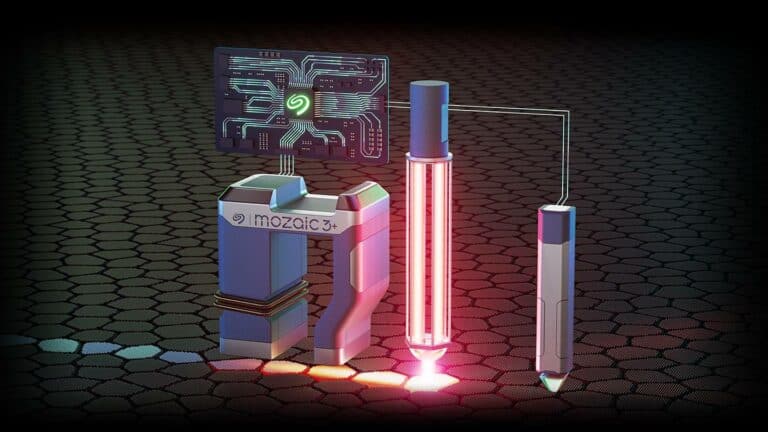Heat-Assisted Magnetic Recording (HAMR) has long been seen as a promising technology that more than doubles the capacity of HDDs. Seagate is now fulfilling this promise by integrating Mozaic 3+ into its Exos data centre HDDs.
HAMR’s predecessors, CMR (Conventional Magnetic Recording), SMR (Shingled Magnetic Recording) and PMR (Perpendicular Magnetic Recording), are widely represented in HDDs on the market. However, the methods of the older magnetic write heads are running into limits to get more data on the magnetic particles of a disk. As a result, HDD manufacturers are struggling to increase the storage capacity of the drives significantly further.
With HAMR, there is a technology that allows drives to store much more data. This is mainly due to the heating technique used. To write the data off, a small area of the magnetic disk is heated, making the magnetic grains in the area more receptive to the magnetic field.
In principle, work on implementing HAMR in HDDs has been ongoing for some time. Still, it took a long time before the technology could be deployed in a commercially attractive way. Now, with the introduction of Mozaic 3+ in its Exos drives, Seagate aims to turn the tide and further increase HDD storage capacity.
Bits per platter
Seagate has achieved an areal density of 3 TB with Mozaic 3+, mainly thanks to Heat-Assisted Magnetic Recording. For the storage capacity of a new Exos, that means at least 30 TB. According to Solution Engineer Jörg Andreas, whom we spoke to, a 30 TB drive is just the beginning. Now that the technology has finally become usable in HDDs, further development should increase capacity. Consideration is given to stretching the number of “bits per platter” stored even further, with an area density of 4 TB and eventually 5 TB in sight.
The storage media with which the new Exos drives will compete are often based on PMR. Advanced drives with that technology have about 24 TB of capacity—however, the average HDD in data centres stores about 16 TB of data. Upgrading an average data centre HDD will thus lead to doubling the capacity.
Vincent Oostlander, Director of Solutions EMEA Sales, adds that increasing that capacity is critical to the market. Predictions assume that the amount of data stored within a few years will double from today. A possible answer is a technology that doubles the areal density and storage capacity.
With Mozaic 3+ Seagate will be able to support the data explosion. The Exos drives will eventually play a significant role in data centres, first at hyperscalers AWS, Microsoft Azure and Google Cloud, where Seagate HDDs are already being used. After that, the drives should become more widely available so other data centre providers can implement them.
Increasing density in operation
HAMR technology makes the new Exos HDDs an interesting storage innovation. To make this technology possible, Seagate looked at optimizing other components of the Mozaic 3+ platform. With Superlattice Platinum-Alloy Media, Seagate has found a technology to support increasing density. This structure takes into account the fact that magnetic bits get closer together. Superlattice Platinum-Alloy Media ensures that each nanoparticle acts as a piece of data. The structure ensures that the magnetic orientation of the material remains stable so that each part continues to be utilized.
The precise writing of data is then done in Mozaic 3+ via the Plasmonic Writer. This laser can accurately heat a nanoparticle on the Superlattice Platinum-Alloy Media structure. The heating technique makes writing data with reduced magnetic field strength possible.
Then, to read the data as well, Mozaic 3+ features a Gen 7 Spintronic Reader. This reader head features magnetic and non-magnetic layers, ultimately making it capable of handling the high data density.
With this, the components of Mozaic 3+ are capable of revitalizing HDDs. It brings new potential to the somewhat older storage medium. We are curious to see how this technology continues developing and how the market will react.
Tip: Seagate introduces IronWolf Pro HDD for NAS deployment with up to 24 TB


